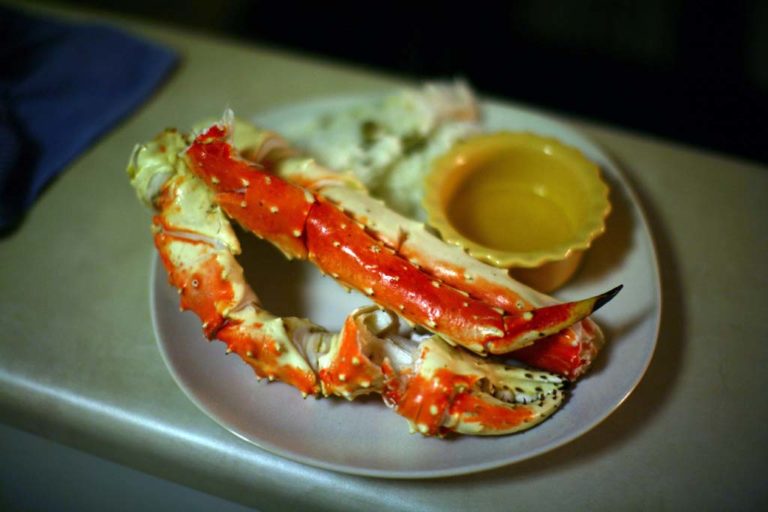
Chef's notes:
There are 40 species of king crab, and the most popular is the red king crab (Paralithodes camtschaticus). The red king crab is also known as Alaskan king crab, as it is native to the Bering Sea and other waters near Alaska. In the 1960s, the Soviet Union introduced the red king crab to one of their bays to provide a new catch for Soviet fisherman. The red crab has thrived there and is now caught by both Norwegian and Russian crab fisherman. Even though it is an invasive species and is becoming a threat to local species, it is protected and viewed as a valuable asset to both countries. Locally, the native Alaskan red crab population has been in steady decline, and unfortunately no one really knows why. Hopefully they will figure it out, so we can continue to eat Alaskan crab and not the imported stuff.
Ingredients
- 4 pounds red king crab
- ¼-½ cup salt
- water
King Crab Recipe: King Crab Leg Clusters Boiled in Salted Water and Served with Clarified Butter
- The king crab legs you purchased at your local grocery store were cooked moments after the crab was killed. So all that is really required of you is to reheat the crab and eat it. As far as I know all king crab is processed this way. Once you purchase the frozen crab, thaw it overnight in the fridge or cook it from frozen. I have done both and not surprisingly they both work fine.
- The best way to reheat crab is to boil it in seawater, but if you don't live near a sea, you can use saltwater. The difficulty you will be faced with is finding a pot big enough to reheat the crab. You can chop the king crab legs at the joints to make them smaller. Or you can use a large roasting pan and place it over two burners on high. It worked perfectly for me. Cover the pan with foil while it heats up. Also dump ¼-½ of salt in the pan to make it salty.
- If you reheat the crab from frozen, boil it for 10-12 minutes in the saltwater. If the crab is thawed, cook it for 7-8 minutes. Don’t put the crab in the pot until you have a rolling boil. Once you have put the crab in the pot, try to keep the boil to a simmer. After the time has passed, the crab will be up to heat. Remove the crab with spring-loaded tongs to a cutting board.
- Let the crab drain for a minute on the cutting board. Some water will come out of the legs while it sits on the board. Before serving the crab, break the crab into three pieces by cutting at the joints. Any large sharp knife will cut through the exoskeleton, but a cleaver works the best. If you don’t have crab crackers (pliers), notch the exoskeleton with a knife so that your guests can break the crab open. Traditionally, crab should be served with clarified butter. Directions for clarified butter are on the right.
- Variations on cooking king crab. Since you are only reheating the crab, there are a number of ways to do so. The best application of heat is a wet heat, i.e., steam. So you can steam it in a pouch in the oven or on the grill. The difficulty with the pouch technique is the crab is sharp and will easily tear a hole in the pouch. You can boil it in the oven, but that presents some logistics issues. Or you could grill it. These other ideas have realistic applications, but the technique described above is the best I have found.
Tips & Tricks
- Don’t cast aside the body meat. It is delicious and tastes almost as good as the leg meat. If you have some leftover, save it and put in a casserole or something.
- Many seafood purveyors have weekly sales on crab and may offer a discount on a certain day of the week. Look into it and see what you can find.
- It is difficult to check the internal temperature of crab, but the best place to check is a the base of the claw at the joint. The temp should be around 160 degrees F or so.
Clarified Butter Recipe
- 1 cup unsalted butter
Melt half a pound of butter in a sauce pan without stirring it. Remove it from the heat once the butter has melted, and don’t stir it. Use a spoon to scoop off the foam, and throw the foam away. Once you have the foam removed, pour the butter out of the pan slowly and smoothly. It should look like a clear, yellow liquid now, which is the clarified butter.
